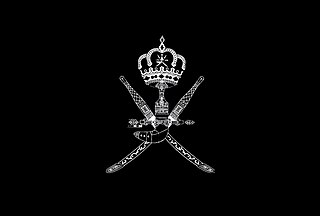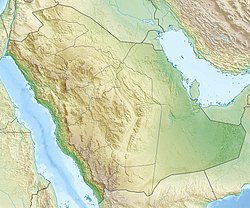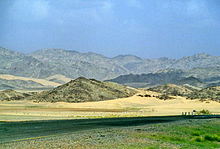
Mecca is the capital of Mecca Province in the Hejaz region of western Saudi Arabia and the holiest city in Islam. It is 70 km (43 mi) inland from Jeddah on the Red Sea, in a narrow valley 277 m (909 ft) above sea level. Its last recorded population was 2,385,509 in 2022. Its metropolitan population in 2022 is 2.4 million, making it the third-most populated city in Saudi Arabia after Riyadh and Jeddah. Around 44.5% of the population are Saudi citizens and around 55.5% are foreigners from other Muslim countries. Pilgrims more than triple the population number every year during the Ḥajj pilgrimage, observed in the twelfth Hijri month of Dhūl-Ḥijjah. With over 10.8 million international visitors in 2023, Mecca was one of the 10 most visited cities in the world.

Najd is the central region of Saudi Arabia, in which about a third of the country's modern population resides. It is the home of the House of Saud, from which it pursued unification with Hejaz since the time of the Emirate of Diriyah.

The Hejaz is a region that includes the majority of the west coast of Saudi Arabia, covering the cities of Mecca, Medina, Jeddah, Tabuk, Yanbu, Taif and Baljurashi. It is thus known as the "Western Province", and it is bordered in the west by the Red Sea, in the north by Jordan, in the east by the Najd, and in the south by the Region of 'Asir. Its largest city is Jeddah, which is the second-largest city in Saudi Arabia, with Mecca and Medina, respectively, being the fourth- and fifth-largest cities in the country.
The Quraysh were a grouping of Arab clans that historically inhabited and controlled the city of Mecca and its Kaaba. The Islamic prophet Muhammad was born into the Hashim clan of the tribe. By 600 CE, the tribe were affluent merchants who dominated commerce between the Indian Ocean and East Africa on one side and the Mediterranean on the other. They organized caravans that traveled to Gaza and Damascus in the summer and to Yemen in the winter. On those routes, they were also engaged in mining and other enterprises. They were known for their hilm, or "absence of hotheadedness," because, despite their rivalries, they put commercial interests and unity first.

This article is about the Province of Mecca. For the city, see Mecca. For other uses, see Mecca (disambiguation)

The Emirate of Diriyah, also known as the First Saudi State, was established in February 1727. In 1744, the emir of a Najdi town called Diriyah, Muhammad bin Saud, and the religious leader Muhammad ibn Abd al-Wahhab formed an alliance to found a socio-religious reform movement to unify the many states of the Arabian Peninsula.

The Banu Thaqif is an Arab tribe which inhabited, and still inhabits, the city of Ta'if and its environs, in modern Saudi Arabia, and played a prominent role in early Islamic history.
There were several Arabian tribes that interacted with Muhammad.
Muhammad led the Conquest of Mecca in Ramadan of the Islamic year 8 AH. The Quraysh in Mecca was Muhammad's final major rival in the Arabian Peninsula, and following the conquest, Muhammad focused his military operations on further expansion of his Islamic realm to the north, with a campaign against the Ghassanids and the Byzantine Empire.

Al-Ghamdi is an Arabic family name denoting a member of the Ghamd tribe of Saudi Arabia.

Zahran, also known as Banū ʿZahrān ibn Kaʿab, is one of the oldest Arabian tribes in the Arabian Peninsula. It is regarded as one of the largest tribes in Al Bahah Province.

The Otaibah is one of the biggest Arab tribes originating in the Arabian Peninsula. Their distribution spans throughout Saudi Arabia, especially in Najd. and the Middle East. The Otaibah are descended from the Bedouin. They trace back to the Mudar family and belong to the Qays ʿAylān confederacy through its previous name, Hawazin.

The Unification of Saudi Arabia was a military and political campaign in which the various tribes, sheikhdoms, city-states, emirates, and kingdoms of most of the central Arabian Peninsula were conquered by the House of Saud, or Al Saud. Unification started in 1902 and continued until 1932, when the Kingdom of Saudi Arabia was proclaimed under the leadership of Abdulaziz, known in the West as Ibn Saud, creating what is sometimes referred to as the Third Saudi State, to differentiate it from the Emirate of Diriyah, the First Saudi State and the Emirate of Nejd, the Second Saudi State, also House of Saud states.

The Hawazin were an Arab tribe originally based in the western Najd and around Ta'if in the Hejaz. They formed part of the larger Qays tribal group. The Hawazin consisted of the subtribes of Banu Sa'd, and Banu Jusham, as well as the powerful Banu Thaqif and Banu Amir, which were both often counted separately from the Hawazin.
Sultan bin Bajad bin Humaid al-'Utaybi was the Sheikh of the Otaibah tribe and one of the prominent leaders of the Ikhwan movement in the Arabian Peninsula. This tribal army supported King Abdulaziz in his efforts to unify Saudi Arabia between 1910 and 1927.

The destruction of heritage sites associated with early Islam is an ongoing phenomenon that has occurred mainly in the Hejaz region of western Saudi Arabia, particularly around the two holiest cities of Islam, Mecca and Medina. The demolition has focused on mosques, burial sites, homes and historical locations associated with the Islamic prophet Muhammad, his companions, and many of the founding personalities of early Islamic history by the Saudi government. In Saudi Arabia, many of the demolitions have officially been part of the continued expansion of the Masjid al-Haram at Mecca and the Prophet's Mosque in Medina and their auxiliary service facilities in order to accommodate the ever-increasing number of Muslims performing the pilgrimage (hajj).

Banu Hudhayl is an Arab tribe that originated in the Hejaz. The tribe mainly inhabits Saudi Arabia, Tunisia, Jordan and Egypt. The tribe was one of the tribes in contact with the Islamic prophet Muhammad and they are known throughout history for their talented poets and intellectuals.
The Ghamd is an Azd Arab tribe of the Hejaz Region. They are predominantly Sunni, and are considered one of the oldest tribes of the Arabian Peninsula. The Ghamid people are thought to be closely related to the neighboring tribe of Zahran.
The Taif massacre was an incident that followed the short 1924 Battle of Taif; the entire episode is also known as the al-Taif incident. The battle and resultant massacre comprised the first major standoff of the Second Hashemite-Saudi War. Following a short siege, the city was abandoned by Hashemite forces and then capitulated to the battle-ready Ikhwan force under the command of Abdulaziz Ibn Saud. The Ikhwan troops took out their rage on the residents of the city. In the resulting bloodbath, some 300-400 Ta'if residents were massacred.

Al-Qantara Mosque, also known as Al-Madhoun Mosque or Qabil Mosque, is an abandoned historical mosque from the Ottoman era in the neighbourhood of Al-Mathnah in the city of At-Ta’if, Saudi Arabia.





























